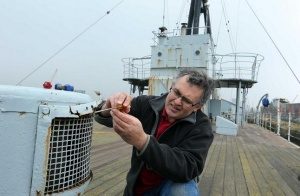Role: Marine Electrician and Ship Keeper
Company: HMS Caroline
Track Record: Museum curators put together and look after collections which are sometimes ancient, often rare and usually priceless.
Marine electrician, self taught curator and ship keeper Billy Hughes looks after a 99 year old war ship which was decommissioned two years ago, is deteriorating by the day and needs urgent repairs to secure it from further wind and water damage.
But thanks to Billy’s efforts the ship, which now belongs to the National Museum of the Royal Navy, has not yet sunk into the mud at the bottom of Belfast’s Alexandra Dock.
Tucked away out of sight in Belfast Harbour between the Titanic Film Studios and the Innovation Centre on Queen’s Island, the dock has been home to the sleek, WW1 light cruiser Caroline for almost 90 years.
Before the vessel was moored here it saw action in the famous Battle of Jutland in 1916 in which the Imperial German Navy was routed. It subsequently went on tours of duty to the Far East and in the twenties it came to Belfast. Here it went back into action WW2 as a command headquarters for the Royal Navy north Atlantic operation.
Billy knows all this and much more about the ship. He’s been a part of the Caroline for the last 30 years and he’s so closely tied to the fate of the ship that his children refer to it as ‘Daddy’s boat’.
Today, the National Museum of the Royal Navy and DETI are currently raising funds for the ship’s restoration in time for the 2016 Battle of Jutland centenary.
TELL US ABOUT A TYPICAL DAY?
7.30am
Despite starting work on the Caroline later in the morning, I’m up to get the children ready for school. My partner is training to be a mid-wife and I am keen to ensure she has the time to concentrate on the studies. I start getting the tools ready for the day – I usually have a good idea of the work schedule ahead.
10.00am
I open up the ship which is still heavily secured. HMS Caroline was decommissioned by the MoD exactly two years ago and even if she is deteriorating there is a strict routine to the maintenance work a marine engineer must undertake.
What’s different about this ship is that many of the electrics date back to the earliest days of the technology revolution. I’ve been working on the ship for 30 years so I know pretty much every square inch of it and where the weak spots are.
11.30am
After the Berlin Wall came down in 1989, MoD cuts meant there was only a marine fitter and me to look after Caroline. We also had to maintain Royal Navy Reserve small launches then. When the MoD decommissioned it in March 2011 I was handed the keys by the commander and told: “It’s all yours.”
Today I am alone although my father George who was a shipwright on board the ship helps me. At around this time we take stock of the problems from the night before – right now we are monitoring the rate of leakage at the very base of the hull beneath the engine room. Last year it was leaking at a rate of two inches of water a month, now it’s four inches a week.
1.00pm
A quick cup of tea and a sandwich – the ship has some updated galley facilities where we can at least boil a kettle – and I’m off again checking the schedule of work and defect list and ensuring the jobs are all done on time.
2.00pm
Quite often around this time there might be visitors who have prearranged a tour – these visitors tend to be Naval veterans, researchers, occasional politicians and National Museum Royal Navy curators.
I also get occasional film stars – Sir Ben Kingsley was here a couple of months ago to research a period movie – and documentary makers through the PR effort under way to raise Caroline’s profile. I have a soft spot for the ghost hunters of which there are a few in Belfast and for whom Caroline is a big attraction.
That’s because the ship is haunted by a dead chief stoker, or so I’m told.
A ghost hunter recently visited the bowels of the ship one night and phoned me to ask who the man in the boiler suit was who had just walked past her. I told her there was no man in a boiler suit. True story.
4.00pm
My work ranges from lamp tramping to deck scrubbing. This means every possible job on board has to be done by me.
I walk the ship from bow to stern and every deck (there are five) has to be checked for lights and maintenance. From the torpedo rooms and turbine halls to the tiller flat where the steering mechanism is located, I have to check and recheck all the time. Up on deck I am currently scrubbing the timbers to make them less slippery.
Not that I expect many visitors but I am hoping that the funding will soon be confirmed so that proper restoration and preservation work can start. In the mean time I do what I can to keep Caroline out of trouble.
7.00pm
By this time, the silence on board is pretty much complete and as the night approaches I can hear the ship’s chains rattle against the stone dock and the water lap against the hull as the vessel moves slightly with the tide.
8.00pm
It’s usually time to go home but when it’s cold as it was two winters ago and six inch pipes on board were splitting threatening to flood the vessel in the thaw, I stayed to pump the water off. Thanks to this gentle winter, so far, I’m able to get home.


